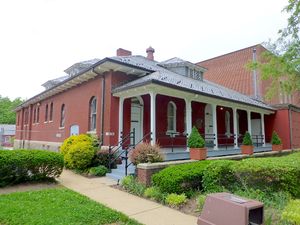Fort Myer: Difference between revisions
John Stanton (talk | contribs) No edit summary |
John Stanton (talk | contribs) No edit summary |
||
| Line 20: | Line 20: | ||
The post was situated on high ground northeast of present day Arlington Boulevard and Pershing Drive. It was a bastioned earthwork with a perimeter of 640 yards and emplacements for 47 guns. This fort was one of the few earthworks fortifications around Washington retained after the end of the [[U.S. Civil War]]. | The post was situated on high ground northeast of present day Arlington Boulevard and Pershing Drive. It was a bastioned earthwork with a perimeter of 640 yards and emplacements for 47 guns. This fort was one of the few earthworks fortifications around Washington retained after the end of the [[U.S. Civil War]]. | ||
The post was upgraded with permanent type buildings beginning in 1872 and became Fort Myer on 4 Feb 1881. The post was divided by the [[:Category:Arlington National Cemetery]] into two separate areas. | The post was upgraded with permanent type buildings beginning in 1872 and became Fort Myer on 4 Feb 1881. The post was divided by the [[:Category:Arlington National Cemetery|Arlington National Cemetery]] into two separate areas. | ||
{{FortMyerCmdrs}} | {{FortMyerCmdrs}} | ||
Revision as of 10:35, 6 June 2016
|
Fort Myer (1861-Present) - From the original 1,100 acres of the Custis-Lee Estate, it was first established as a Union defense in 1861 during the U.S. Civil War when Fort Cass (2), Virginia, a lunette which was constructed by the 9th Massachusetts Infantry Regiment in June 1861, the name of the fortification was later changed to honor Colonel Thomas Cass, the regiment’s first commander who was killed in 1862 and later included an additional fortification Fort Whipple (1). Named after Major General Amiel W. Whipple (Cullum 1063), who died 7 May 1863 of wounds suffered at the Battle of Chancellorsville. Fort Whipple (1) was renamed Fort Myer on 4 Feb 1881 for Brigadier General Albert J. Myer, first U.S. Army Chief Signal Officer. Active military installation.
Fort Myer History   Established as Fort Whipple during the U.S. Civil War and became one of the circle of Union defenses around Washington DC. Fort Whipple was built in 1862 on property then known as the Arlington Estate of Confederate General Robert E. Lee which overlooked the Potomac River and Washington DC. The post was situated on high ground northeast of present day Arlington Boulevard and Pershing Drive. It was a bastioned earthwork with a perimeter of 640 yards and emplacements for 47 guns. This fort was one of the few earthworks fortifications around Washington retained after the end of the U.S. Civil War. The post was upgraded with permanent type buildings beginning in 1872 and became Fort Myer on 4 Feb 1881. The post was divided by the Arlington National Cemetery into two separate areas.
Current StatusAn active military installation, a part of the U.S. Army Military District of Washington and Joint Base Myer-Henderson Hall. Units stationed at the fort provide protection for the President and the Capitol, they guard the Tomb of the Unknown Soldier 24/7, and they furnish military units for ceremonies held within the adjacent Arlington National Cemetery and the Capitol complex. The Old Guard (3rd U.S. Infantry) stationed at Fort Myer is the Army's official ceremonial unit and escort to the president, and it also provides security for Washington, D.C., in time of national emergency. The units of the 3rd U.S. Infantry stationed at Fort Myer provide details for standard and full honors funerals in Arlington National Cemetery and for dignified transfers at Dover Air Force Base. The Old Guard's ceremonial tasks include full honor arrivals for visiting dignitaries, wreath ceremonies at the Tomb of the Unknowns, and full honor reviews in support of senior army leaders and retiring soldiers. They provide 24/7 Tomb Guards at the Tomb of the Unknowns and special ceremonial units including three Colonial Marching Platoons, the Old Guard Fife & Drum Corps, the Continental Color Guard, the United States Army Drill Team, the Presidential Salute Battery and the US Army Caisson Platoon.
See Also:
Sources:
Links: Visited: 21 May 2013 | ||||||||||||||||||||||||||||||||||||||||||||||||||||||||||||||||||||||||


